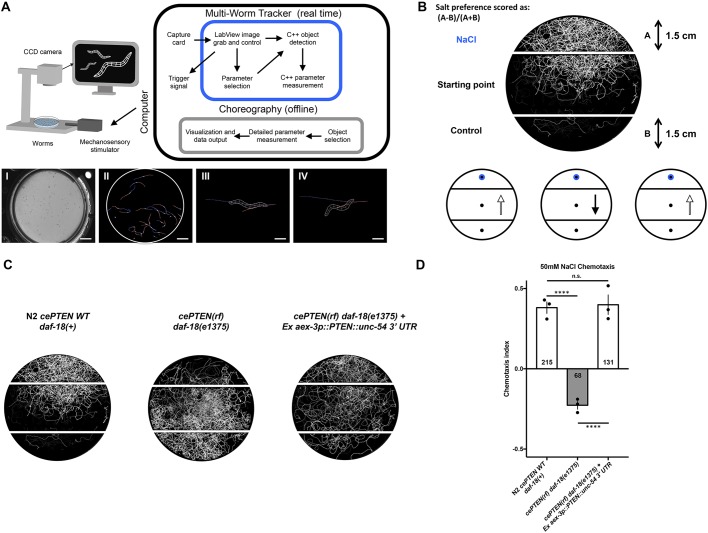Fig. 3.
A conserved neuronal role for PTEN in NaCl preference revealed by a novel automated chemotaxis paradigm. (A) (Top) All phenotypic analysis was conducted using our machine vision system, the Multi-Worm Tracker. The Multi-Worm Tracker delivers stimuli and performs image acquisition, object selection and parameter selection in real time, while Choreography software extracts detailed phenotypic information offline. (Bottom) (I) A Petri plate of C. elegans; (II) a Petri plate of C. elegans selected for analysis by the Multi-Worm Tracker; (III and IV) Multi-Worm Tracker digital representations showing the degree of phenotypic detail. An example behavior scored by the Multi-Worm Tracker: the C. elegans response to a mechanosensory tap to the side of the Petri plate is brief backwards locomotion (from III to IV). Scale bars: 1 cm (I and II), 0.25 mm (III and IV). (B,C) Behavioral track tracing of a plate of worms from a novel automated Multi-Worm Tracker NaCl chemotaxis paradigm, illustrating attractive navigation behavior of wild-type animals toward a point source of NaCl. (B) Circles and arrows (bottom, left to right) and (C) worm tracks (left to right) represent navigation trajectories of wild-type attraction to a point source of NaCl, a daf-18(e1375) reduction-of-function decrease in NaCl chemotaxis, and a transgenic rescue of NaCl preference via pan-neuronal overexpression of wild-type human PTEN in daf-18(e1375) reduction-of-function mutants. (D) Quantitative chemotaxis index scores across genotypes. Pan-neuronal expression of human PTEN rescues the reversed NaCl preference of daf-18(e1375) mutants to wild-type levels. Circles represent plate replicates run on the same day; numbers in bars represent the number of individual animals registered by the tracker and located outside the center starting region (i.e. included in the preference score) across the three plate replicates for each genotype. Error bars represent s.d., using the number of plates as n (n=3). ****P<0.0001; n.s., not significant; one-way ANOVA and Tukey's post hoc test.

